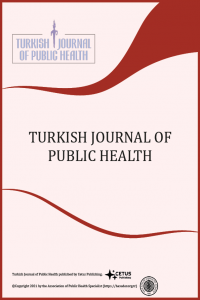Gülşen BARLAS, Ebru TOZAN, Yüksel ALTUĞ, Dilber AKTAŞ, Fehminaz TEMEL, Gülay KORUKLUOĞLU, Mustafa Bahadır SUCAKLI
Kütahya İli Tavşanlı İlçesinde ishal salgını incelemesi, Temmuz 2014, bir olgu-kontrol çalışması
Amaç: Tavşanlı ilçesi halk sağlığı yetkilileri 18.06.2014 tarihinde 28’i hastanede yatarak tedavi görmüş 684 gastoenterit hastası olduğunu rapor etmişlerdir. İnceleme, salgının nedenini saptamak, bulaş yolunu belirlemek ve kontrol önlemlerini uygulamak amacıyla yapılmıştır. Yöntem: Bu vaka-kontrol çalışmasında 07–30 Haziran tarihleri arasında R11, K52, A09 ICD-10 tanı kodlu, kusma veya ishali (≥3/gün) olan, atak hızı en yüksek 5 mahallede ikamet eden, basit rastgele yöntemle seçilen 154 olası olgu ve kontrolü incelenmiştir. Kontroller, 1:1, yaş grubu eşleştirmesi yapılarak komşulardan seçilmiştir. Klinik örnekler ve şebeke suyu örnekleri incelenmiştir. Bulgular:Atak hızı %3.3 olup vakalar tüm ilçeye yayılmıştır. Başlıca şikâyetler bulantı (%88.9), ishal (%88.2), karın ağrısı (%82.8) ve kusmadır (%71.8). Vakalar selden 6 gün sonra artmaya başlamış ve salgın eğrisinde geniş bir pik saptanmıştır. Vakaların %66.9’u, kontrollerin ise %37.0’ı mahalle çeşme suyu (TRRMH=4.3 ,%95 GA:2.2-8.6), vakaların %18’i kontrollerin %27’si şişelenmiş su içmiştir (TRRMH=0.5, %95 GA:0.3-0,9).Beş adet dışkı örneğinde Norovirüs GI ve GII saptanmıştır. Çevresel araştırmalarda ilçede 35 kontrolsüz mahalle çeşmesi olduğu, bunları besleyen su deposunun sel suyu ile tamamen dolmuş olduğu öğrenilmiştir. Su örneklerinde norovirüs tespit edilememiştir. Sonuç: Vakalarda norovirüs saptanması, korunaksız mahalle çeşmesi deposunun taşkın yaşanan kanalın hemen yanında bulunması ve çalışmada elde edilen bulgular, salgının olası nedeninin şiddetli yağış sonrasında kontamine olan mahalle çeşmelerinden su tüketilmesi olduğunu düşündürmektedir.
Anahtar Kelimeler:
Nörovirüs, Eşleşmiş Vaka-Kontrol Çalışmaları, Su, İshal
An investigation of an outbreak of gastroenteritis in the Tavsanli District of Kutahya Province, July 2014, a Case-Control Study
Objective: On 18.06.2014 health authorities of the Tavsanli district reported 684 gastroenteritis patients; of whom 28 were hospitalized. We investigated this outbreak to identify the cause, mode of transmission and to implement control measures. Method: In this case-control investigation, we evaluated 154 probable cases defined as onset of vomiting or diarrhea (≥3/day), which were randomly selected from the 5 neighborhoods with highest attack rates. These were diagnosed as A09, R11, K52 ICD-10 codes between the 7th and the-30th June; and their age-groups were matched 1:1 with neighborhood-controls. Clinical and tap water samples were collected. Results: The attack rate was 3.3% and cases were widespread in the district. Main symptoms were nausea (88.9%), diarrhea (88.2%), abdominal pain (82.8%), and vomiting (71.8%). The symptoms started to increase 6 days after a flood, and the epidemic curve revealed a high peak. 66.9% of cases (103/154) had drunk from a neighborhood water fountain, compared with 37% (57/154) of the controls (ORMH=4.3, 95% CI=2.2-8.6); 18% (28/156) of cases compared with 27% (43/95) of the controls used bottled water (ORMH=0.5, 95% CI=0.3-0.9). Norovirus was detected in five stool specimens. Environmental investigation showed that there were 35 untreated neighborhood fountains and that the water tanks that providing water to neighborhood fountains was full of flood water. Norovirus was not identified in the water samples. Conclusion: The findings of the study reveal that this norovirus outbreak was likely due to drinking contaminated water from neighborhood fountains after the flood due to an unprotected neighborhood storage tank next to a canal, supplying the fountains.
Keywords:
Norovirus, matched case-control study, water, diarrhea,
- Başlangıç: 2003
- Yayıncı: Halk Sağlığı Uzmanları Derneği
Sayıdaki Diğer Makaleler
Kütahya İli Tavşanlı İlçesinde ishal salgını incelemesi, Temmuz 2014, bir olgu-kontrol çalışması
Gülşen BARLAS, Ebru TOZAN, Yüksel ALTUĞ, Dilber AKTAŞ, Fehminaz TEMEL, Gülay KORUKLUOĞLU, Mustafa Bahadır SUCAKLI
Zeliha Aslı ÖCEK, Ece EDEN, Meral TÜRK, Nurcan ÇAKIR
Toplum sağlığı merkezi sorumlu hekimlerinin gözüyle toplum sağlığı merkezlerinin genel özellikleri
Mehmet Enes GÖKLER, Egemen ÜNAL, Reşat AYDIN, Gülsüm ÖZTÜRK EMİRAL, Selma METİNTAŞ, Burhanettin IŞIKLI, Muhammed Fatih ÖNSÜZ
Sağlık psikolojisi bakış açısından karar anı teşviklerinin merdiven kullanımı üzerindeki etkileri
